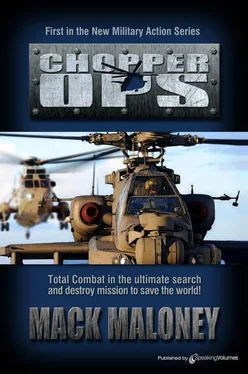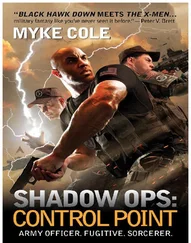Mack Maloney - Chopper Ops
Здесь есть возможность читать онлайн «Mack Maloney - Chopper Ops» весь текст электронной книги совершенно бесплатно (целиком полную версию без сокращений). В некоторых случаях можно слушать аудио, скачать через торрент в формате fb2 и присутствует краткое содержание. Город: Naples, FL, Год выпуска: 2011, ISBN: 2011, Издательство: Berkley, Жанр: Боевик, на английском языке. Описание произведения, (предисловие) а так же отзывы посетителей доступны на портале библиотеки ЛибКат.
- Название:Chopper Ops
- Автор:
- Издательство:Berkley
- Жанр:
- Год:2011
- Город:Naples, FL
- ISBN:978-1-61232-148-6
- Рейтинг книги:3 / 5. Голосов: 1
-
Избранное:Добавить в избранное
- Отзывы:
-
Ваша оценка:
- 60
- 1
- 2
- 3
- 4
- 5
Chopper Ops: краткое содержание, описание и аннотация
Предлагаем к чтению аннотацию, описание, краткое содержание или предисловие (зависит от того, что написал сам автор книги «Chopper Ops»). Если вы не нашли необходимую информацию о книге — напишите в комментариях, мы постараемся отыскать её.
Chopper Ops — читать онлайн бесплатно полную книгу (весь текст) целиком
Ниже представлен текст книги, разбитый по страницам. Система сохранения места последней прочитанной страницы, позволяет с удобством читать онлайн бесплатно книгу «Chopper Ops», без необходимости каждый раз заново искать на чём Вы остановились. Поставьте закладку, и сможете в любой момент перейти на страницу, на которой закончили чтение.
Интервал:
Закладка:
The second ferry was about halfway full when the plane finally went by the oil platform. It was flying very low and its engines seemed extremely loud. The plane was painted all black with a charcoal-like quality to the tone. Traces of a camouflage scheme could be seen on the wings and tail.
Many aboard the platform knew what kind of airplane this was: a C-130 Hercules, the ubiquitous American-built cargo hauler and general all-round workhorse of many nations’ air forces. What did mildly surprise some people was that the airplane carried no markings, no tail numbers, no insignia to identify what country it belonged to—this, and the fact that its nose was so long and its fuselage so thick.
The plane passed about one thousand yards to the south of the oil rig and kept on going, disappearing into the mist to the east, possibly heading towards Iran, just forty miles away. The loading of the second ferry was nearly completed, and the third boat was being signaled to come in. That was when the people on the platform heard another thunderclap. All eyes turned east and to everyone’s surprise, they saw the airplane had turned and was coming back.
The workers on the first ferry would have the best view of what happened next.
The plane passed so close to the oil platform this time that the whole structure shook from top to bottom. The water below was suddenly foaming, kicked up by the plane’s engine exhaust. Suddenly three long streaks of flame erupted from the side of the airplane. This fire came so quickly and was so vivid, many on the ferry thought the plane was in trouble and had doubled back, perhaps to attempt an emergency landing near the oil platform.
But a moment later, a geyser of flame erupted from the top of the platform itself. Had the plane flown so close to the rig that it had hit something? No—the plane was still flying. It roared right over the first ferry. Then came a tremendous explosion. It sent shock waves through the ferry and the water around it. All eyes looked up to see the oil platform’s mast disintegrate in a puff of smoke. Now a second explosion went off, louder than the first. An instant later, the entire upper tier of the rig was engulfed in flames. Only then did the people on the ferry realize the airplane had fired on the oil platform.
And now it was coming back again….
The airplane swept by the platform a third time, a continuous stream of fire pouring out of its left side. The oil rig began to shudder, and hundreds of small explosions peppered it up and down. Flame was suddenly everywhere. Many workers began leaping into the water, some on fire themselves. Others were trapped and quickly engulfed in flames.
The plane roared by again. Now a huge gun muzzle could be seen protruding from its left side. It was firing large-caliber projectiles at a frightening rate. The workers on the ferry saw the control house go up first in this fusillade. The main pump hut went next. Then the living quarters, then the turbine station. Oil was gushing wildly out of some pipes now and being ignited in many places.
Inside of ninety seconds, the oil rig was a burning wreck. Bodies were in the water; many more workers were badly burned on the platform itself. The plane went by twice more, delivering high-powered shells in such a methodical fashion, it seemed unreal to the people on the first ferry. Was this really happening? Why would anyone want to destroy Qak-Six?
Stunned, the ferry captain finally started pounding on his vessel’s radio, intent on sending out an SOS. But as soon as he switched his comm set on, it made a loud crack and went dead, a victim of the gunship’s high-powered electronic-jamming suite. The plane went by the oil rig one last time, but there was no shooting this time. This pass was just to survey its deadly work. The sixty-six workers on the first ferry stood on the rail, astounded by what they had just seen. The few people still left on the platform could not have survived the brutal assault—and those injured and in the water would not live for more than a few minutes in the choppy cold sea.
Still, the ferry captain had to make an attempt to rescue any survivors. So he ordered his vessel to turn about and head back toward the burning oil rig.
That was when those aboard the ferry saw the big plane turn once again—and point its nose right at them.
The USS LaSallette was not an ordinary ship.
It was one of the oldest operational vessels in the U.S. Navy, its keel having been laid in the winter of 1955. It boasted very few weapons. Twin .50-caliber machine guns on the stern and bow were its only outward defenses. Its helicopter, a small OH-51, carried only rudimentary antiship missiles and a single .30-caliber machine gun on its nose mount. There were but a dozen M-16’s on board, with a total of three hundred rounds of ammunition available. The only other potential weaponry consisted of some smoke grenades and flares.
The LaSallette was not a warship per se. Its superstructure was a forest of antennae, satellite receivers, radar dishes, and microwave arrays. More than half its crew of 214 worked on monitoring data pulled in by these various devices. Officially, the LaSallette was a C3 platform, for command, control, and communications. In reality, it was a spy ship. It cruised the upper reaches of the Persian Gulf periodically, snooping on Iraqi radio and TV transmissions, gathering intelligence, watching for any military movements. It had been compared to a floating AWACS plane, and this was not entirely inaccurate.
This day it was on a typical SigInt mission. A number of Republican Guard units had been on the move in the upper part of Iraq recently, some heading south, others moving east. Routine maneuvers perhaps. But the LaSallette had been sent into the northern gulf to troll the airwaves for any indications as to what these elite Iraqi units might be up to.
It was by fate then that its course brought it steaming over the horizon just as the AC-130 gunship had finished off the last survivors of Qak-Six’s number-one ferry. With its long-range snooping radar and TV equipment, the LaSallette was suddenly flooded with data emanating from the burning oil platform and the mysterious airplane orbiting above it. There was no doubt among those interpreting this information that the gunship had attacked the oil rig and had killed just about all of its occupants. The proof of this was pouring into the hard drives of the ship’s main computers.
And for the first time in a year and a half of rampage and destruction, the people flying the gunship suddenly had a very big problem on their hands.
They had witnesses.
By the time the LaSallette’s crew were called to their battle stations, the AC-130 was heading for the ship at full speed.
The captain immediately ordered his helicopter to launch. Gunners assigned to the .50-caliber deck guns scrambled to their positions. Everyone above the rank of CPO was issued an M-16 and a clip of ammunition. The communications shack was sending out messages to any and every Allied ship in the immediate vicinity—but the airplane’s jamming suite prevented all but the first few seconds of any message to escape. It made little difference. The captain had already done a sweep of his immediate area. The nearest U.S. ship was sixty miles away.
The LaSallette was trapped and very much alone.
The secure photo-fax machine in Smitz’s billet started beeping at exactly 3 A.M.
The CIA man rolled over, sleepily checked his alarm clock, and then clicked the fax machine’s Receive button.
A red sheet was the first to emerge. It was covered with black dots and a thick black band running diagonally down its side. This indicated the message he was about to receive was of the highest security—Eyes Only—and should be destroyed as soon as he was through reading it.
Читать дальшеИнтервал:
Закладка:
Похожие книги на «Chopper Ops»
Представляем Вашему вниманию похожие книги на «Chopper Ops» списком для выбора. Мы отобрали схожую по названию и смыслу литературу в надежде предоставить читателям больше вариантов отыскать новые, интересные, ещё непрочитанные произведения.
Обсуждение, отзывы о книге «Chopper Ops» и просто собственные мнения читателей. Оставьте ваши комментарии, напишите, что Вы думаете о произведении, его смысле или главных героях. Укажите что конкретно понравилось, а что нет, и почему Вы так считаете.












